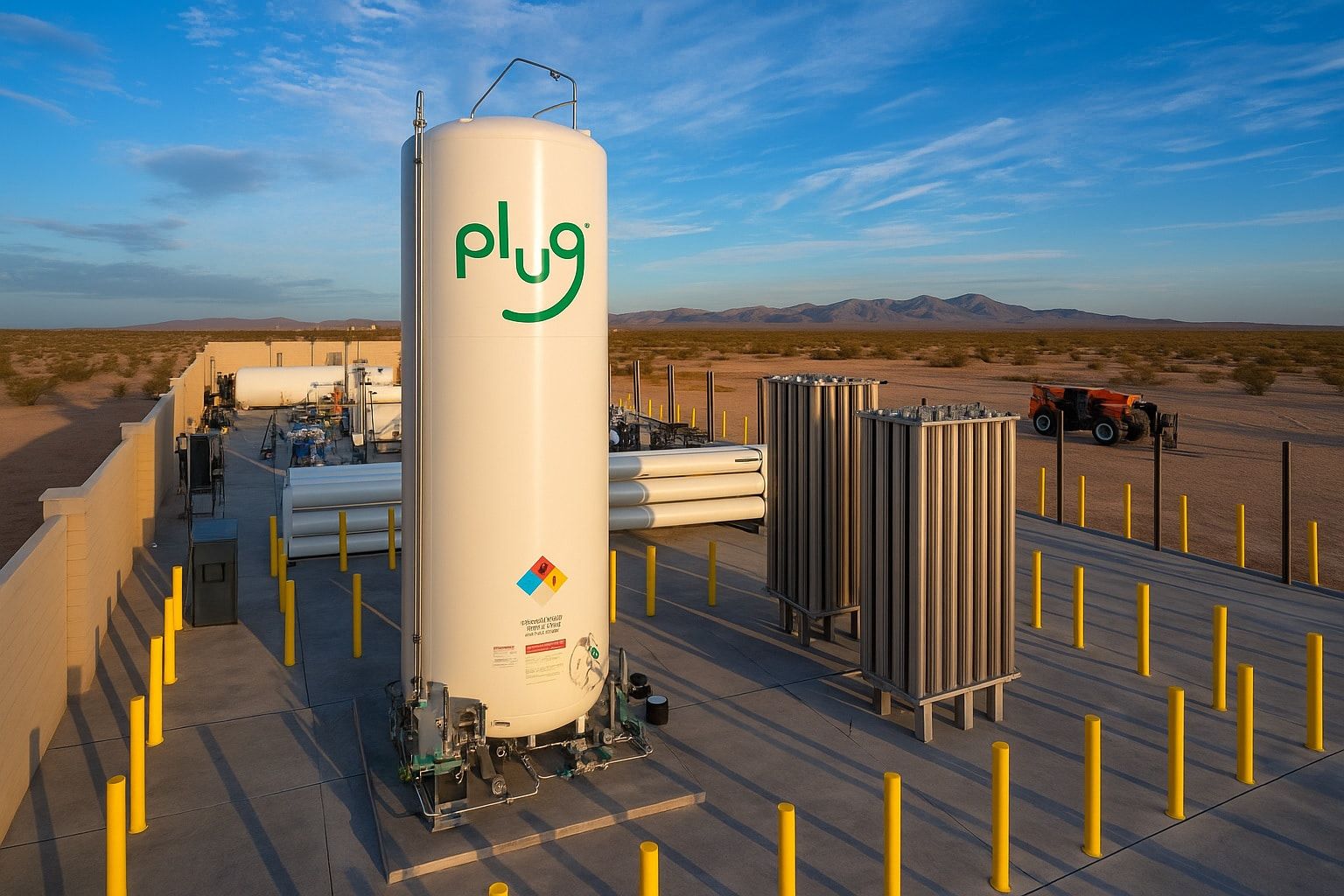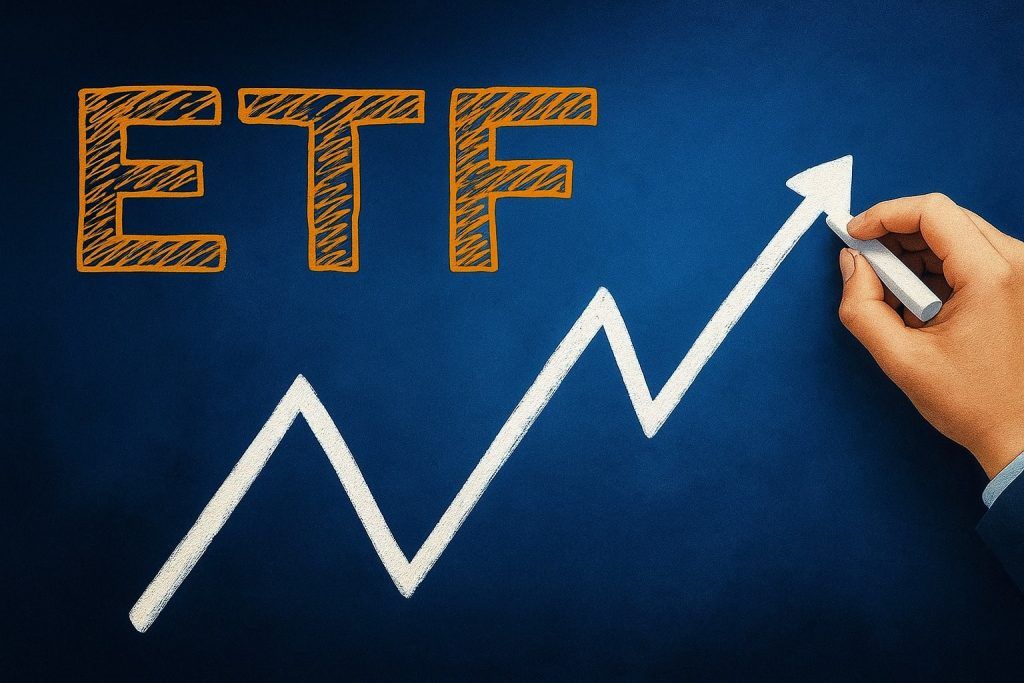- Stock Price & Performance: Plug Power (NASDAQ: PLUG) is trading around $2.70 as of Nov. 3, 2025, after rebounding from sub-$1 lows mid-year. Shares are down roughly 8% in the past week but up about 15% over the past month [1]. Year-to-date, PLUG has climbed ~20%, though it remains over 90% below its early 2021 peak. The company’s market capitalization stands near $3.5 billion [2].
- Latest Financials:Q2 2025 revenue was $174 million (up 21% year-on-year) [3], with electrolyzer sales tripling to $45 M. Gross margin improved to -31% (from a dismal -92% a year prior) [4], reflecting cost cuts, yet net losses persist. Free cash flow remains deeply negative (around -$1 billion annually) as Plug invests heavily in growth [5]. The company held ~$140 M in unrestricted cash mid-year and has $300 M in debt capacity available [6], aiming to reach gross margin breakeven by Q4 2025 [7].
- Leadership Shakeup: Longtime CEO Andy Marsh (at the helm since 2008) will step down by March 2026 in a planned succession. Plug’s Chief Revenue Officer Jose Luis Crespo has been named incoming CEO, becoming President in Oct. 2025 and slated to assume the CEO role after the 2025 annual report [8]. Marsh will transition to Executive Chairman of the board [9]. The company insists the change was long-orchestrated and “entirely unrelated” to recent cuts in federal clean energy funding [10].
- Major Deals & Partnerships: Plug Power is aggressively expanding via new partnerships:
- Allied Biofuels (Uzbekistan): A binding supply agreement for up to 2 GW of Plug’s GenEco PEM electrolyzers was signed in Oct. 2025 to support a landmark sustainable aviation fuel project [11] [12]. This is one of 2025’s largest electrolyzer deals, boosting Plug’s contracted backlog and “underscoring Plug’s growing role” in large-scale green fuel production [13].
- Edgewood Renewables (Nevada): Announced a strategic partnership to co-develop a renewable fuels plant in North Las Vegas that will convert waste biomass into SAF (sustainable aviation fuel), renewable diesel and biomethanol [14] [15]. Plug will provide engineering design, equipment, and project oversight, leveraging its experience building hydrogen plants in Georgia and Louisiana [16] [17].
- Floor & Decor: Deployed a zero-emission fuel cell forklift fleet at Floor & Decor’s Washington distribution center – 77 hydrogen-powered forklifts with on-site GenFuel hydrogen storage & fueling infrastructure [18]. This first hydrogen rollout for a major flooring retailer will cut ~400 metric tons of CO₂ annually [19] and showcases Plug’s dominance in material handling solutions for big-box customers.
- Other initiatives: Plug also expanded hydrogen delivery in Europe (H2CAST project) and is advancing hydrogen deployments in South Korea, India and Japan [20], aiming to be a global “first mover” with 72,000+ fuel cell units and 275 fueling stations deployed to date [21].
- Industry & Policy Context: As a leading hydrogen fuel cell and electrolyzer provider, Plug Power’s prospects are tied to clean energy policy. The company and its peers (e.g. Ballard Power, FuelCell Energy, Bloom Energy) have yet to achieve profitability, relying on scale and government incentives. In the U.S., the extension of clean hydrogen tax credits (45V) through 2027 is a tailwind [22] [23], but the new administration’s rollback of certain green energy incentives has injected uncertainty [24]. (Plug had a $1.66 B DOE loan guarantee for hydrogen plant buildouts [25], now in question.) Moreover, new tariffs on imported fuel cell and electrolyzer components are pressuring costs [26] [27], forcing Plug to localize its supply chain. Globally, however, momentum for hydrogen remains strong – the EU and Asia are investing heavily in hydrogen infrastructure, presenting growth opportunities for Plug’s technology.
- Analyst Sentiment & Outlook: Wall Street is sharply divided on PLUG’s future. The consensus rating is Hold with an average $4.1 one-year price target (≈50% above current) [28], but individual targets range from ultra-bearish $0.50 (Morgan Stanley’s low-end, essentially a 80% plunge) to bullish $7+ (over 100% upside) [29] [30]. Bears cite Plug’s cash burn and long history of missed targets – as one skeptical analyst, Vikram Bagri, reiterates a mere $0.75 target despite the stock’s 250% surge off its lows [31]. Bulls, however, point to improving margins, big-name customers (Amazon, Walmart, Home Depot) and massive revenue ambitions. Plug’s management itself has outlined ambitious 2030 goals – aiming for ~$6 B revenue by 2027 and $20 B by 2030 with 30%+ margins [32] [33] – suggesting huge upside if the hydrogen economy accelerates. In the near term, upcoming Q3 2025 earnings (scheduled Nov. 11) will be crucial; analysts expect continued growth but will watch for progress toward the company’s late-2025 margin breakeven pledge.
Stock Surge from Penny Levels – But Volatility Remains
Plug Power’s stock has been on a wild ride in 2025. After collapsing to penny-stock territory (briefly around $0.70–$0.80 in spring [34]), PLUG staged a dramatic rally over the summer – at one point gaining over 240% in six months [35] amid renewed investor enthusiasm for hydrogen plays. By late October, the stock hit multi-month highs near $3–$4. However, volatility remains extreme. As of November 3, PLUG changes hands around $2.69 per share [36], having pulled back about 20% from its October peak in the past 10 trading days [37] [38].
Even with recent gains, Plug Power is a far cry from its 2021 highs (when hydrogen hype sent PLUG above $70). The current price is roughly 96% below that peak, reflecting the brutal sell-off of 2022–2023 and dilution from capital raises. Still, relative to the start of 2025, the stock is up ~15–20% (depending on the exact date) – a notable outperformer in a year when many clean energy stocks struggled. Over the past month, shares have climbed about 15%, buoyed by bullish news of new deals and optimism around upcoming earnings [39]. In contrast, just the past week saw an ~8% drop as traders likely took profits ahead of earnings and amid broader market jitters [40]. Such swings underline that market sentiment on PLUG can flip quickly, with traders oscillating between excitement over hydrogen’s long-term potential and fear over Plug’s near-term finances.
At ~$2.70 per share, Plug Power’s market capitalization is roughly $3.4 billion [41]. This values the company at about 4.6 times its sales (P/S) – a premium versus traditional industrial peers, but not unusual for a growth-stage clean tech firm [42] [43]. By comparison, Ballard Power and FuelCell Energy (two fuel cell peers) trade at lower market caps and revenue bases, but all share the challenge of heavy losses. Notably, trading volumes in PLUG have been huge – for example, ~94 million shares (over $250 M worth) changed hands on Oct. 31 alone [44] [45] – indicating active speculative interest. Technical indicators are mixed: the stock recently breached short-term support around $2.69, and some chart signals have turned bearish after the October pullback [46]. Analysts caution that PLUG is “very high risk” in the near term due to its volatility (daily swings of 6–8% are common) [47]. However, momentum traders note the stock is currently oversold (14-day RSI ~15) which could portend a relief bounce [48].
In short, Plug Power’s stock has shown signs of life in late 2025 but continues to trade more on future promise than present profits. Investors are closely watching upcoming milestones – especially the path to breakeven gross margins and any funding moves – to gauge whether this year’s rebound is the start of a sustained uptrend or just a temporary spark in a longer downturn.
Financial Check-Up: Revenues Rising, Losses Persist
Plug Power’s financial results paint a picture of strong top-line growth tempered by ongoing bottom-line losses. In the second quarter of 2025, Plug delivered $174 million in revenue, a 21% jump year-over-year [49]. This growth was fueled in part by booming sales of electrolyzer equipment: electrolyzer revenue reached ~$45 M in Q2, more than triple the prior-year level [50] as deliveries of green hydrogen production systems ramped up. This diversification beyond the core fuel-cell forklift business is a positive sign – it means Plug is tapping new markets like hydrogen generation. For context, material handling (fuel cell systems for forklifts) has historically been Plug’s bread-and-butter, with anchor customers including Amazon, Walmart and Home Depot. That business provides recurring fuel revenue as well. But the electrolyzer segment’s rapid growth suggests Plug is successfully penetrating the green hydrogen production market, which could greatly expand its addressable revenue.
Crucially, Plug’s profit margins are improving, though still negative. Gross margin in Q2 was -31%, meaning the company still spent more to produce its products than it sold them for. Yet this is a major improvement from the -92% gross margin in Q2 2024 [51]. The margin boost indicates Plug’s cost-cutting and scaling efforts are bearing fruit. Management highlighted a program called “Project Quantum Leap,” which has streamlined operations – optimizing the workforce, consolidating manufacturing sites, and renegotiating supplier contracts [52]. Thanks to these efforts, Plug nearly tripled its gross profit (on a negative basis) year-over-year. The company is targeting gross margin breakeven by late 2025, and indeed expects to hit positive gross margin on a run-rate basis in Q4 2025 [53]. Achieving that would be a pivotal turning point, proving that its hydrogen solutions can be produced and delivered without losing money.
Below the gross line, however, operating expenses remain heavy. R&D and SG&A costs – as Plug continues building out its hydrogen ecosystem – keep the company in the red. Plug hasn’t reported Q3 2025 results yet (due Nov. 11), but in Q2 it recorded a net loss of roughly $236 M (EPS around -$0.20, missing estimates) according to analyst reports [54]. The free cash flow situation is a particular concern for skeptics: Plug’s latest twelve-month free cash flow was about -$1.03 billion [55]. In the first half of 2025 alone, operations burned $297 M in cash [56]. The company has been funding its growth through a mix of cash on hand, debt facilities, and equity raises (including at-the-market stock offerings). As of mid-2025, Plug had over $140 M of unrestricted cash and access to $300 M in additional debt [57]. Notably, management stated they do not expect to tap their ATM (at-the-market) share issuance program in 2025, aiming to avoid dilution [58]. Instead, they’ve arranged alternative financing like a second tranche from partner Yorkville Advisors if needed [59].
Encouragingly, Plug’s cash burn has been moderating. In Q1 2025, operating cash flow improved and cash burn was about 47% lower than a year prior [60]. The company also touted that it expanded hydrogen production to 40 tons per day by bringing new green hydrogen plants online [61] – which should eventually translate to high-margin fuel sales. Still, until Plug actually generates positive cash flow, financing needs will linger. The good news: Plug’s CFO Paul Middleton appears confident, evidenced by his personal purchase of 350,000 shares of PLUG stock on the open market [62]. Such insider buying (at depressed prices earlier in 2025) “reflects his belief in Plug Power’s financial health and growth trajectory” [63]. It’s a signal to investors that management expects the massive investments in factories, hydrogen plants, and product development to pay off in coming years.
In summary, Plug Power’s financials show a company at an inflection point – revenues are climbing fast and margins are crawling toward breakeven, but losses and cash burn remain significant. The next few quarters will be critical to prove Plug can continue scaling up revenues (especially from new hydrogen segments) while containing costs. Achieving the Q4 gross margin breakeven target [64] would bolster credibility. Conversely, any setback – e.g. a revenue shortfall or margin regression – could revive concerns about the company’s path to profitability.
Big Bets and Bold Partnerships Powering Growth
Plug Power’s strategy in 2025 is clearly “go big or go home” when it comes to growth initiatives. The company has struck a series of major partnerships and deals in recent months, aiming to cement its leadership in the emerging hydrogen economy. These deals span the globe – from Central Asia to the American Southwest – and underscore Plug’s ambition to be more than just a fuel cell supplier, but rather a vertically-integrated hydrogen solutions provider.
One headline-grabbing agreement came on October 30, 2025, when Plug announced a binding supply deal for up to 2 GW of electrolyzers with Allied Biofuels [65]. This project, located in Uzbekistan, is a landmark effort to produce electro-sustainable aviation fuel (eSAF) and green diesel at an immense scale. Allied Biofuels plans a world-scale biorefinery that will use Plug’s PEM electrolyzers to generate green hydrogen, a key ingredient for synthesizing SAF. A final investment decision on the full project is expected in late 2026, but the supply contract firmly places Plug as the technology provider for potentially one of the largest hydrogen-fuel projects on the planet [66]. To put 2 gigawatts in perspective, it’s enough electrolyzer capacity to produce hundreds of tons of hydrogen per day. Plug’s CEO Andy Marsh did not hold back on emphasizing the significance: “This agreement is proof that Plug delivers on what others are still planning. We’re turning hydrogen commitments into real, operating projects at multi-gigawatt scale,” Marsh said [67]. Indeed, if Allied’s Uzbekistan SAF plant comes to fruition, it would be a flagship example of green hydrogen enabling decarbonization of aviation – and Plug’s products would be at its heart. Notably, this deal builds on an earlier 3 GW electrolyzer collaboration in Australia between Plug and Allied’s sister company for green ammonia [68]. In total, Plug now has 5 GW of electrolyzer capacity contracted with the Allied group across two continents [69], an enormous vote of confidence in Plug’s technology.
Closer to home, Plug Power is also entering new arenas of clean fuel. On Oct. 23, 2025, Plug announced a partnership with Edgewood Renewables to develop a renewable fuels plant in North Las Vegas, Nevada [70]. This project will take waste biomass (think plant waste, wood, other organic refuse) and convert it into sustainable aviation fuel (SAF), renewable diesel, and biomethanol [71]. Uniquely, the process will integrate low-carbon hydrogen and renewable natural gas, and all the outputs are “drop-in” fuels compatible with today’s planes, trucks, and ships [72]. Under the deal, Plug Power will handle key engineering design, supply its equipment (likely electrolyzers, hydrogen liquefiers, fuel cell power units, etc.), and oversee fabrication and construction [73]. Essentially, Plug is acting as a technology and EPC partner for this cutting-edge biofuel refinery. Construction is slated to begin in the coming months [74]. For Plug, this is a milestone: it’s the company’s first major foray into biofuels beyond hydrogen [75]. Plug’s involvement draws on its experience building large hydrogen plants (the company commissioned green hydrogen facilities in Louisiana and Georgia in 2023–2024) and its team’s deep project engineering roots (many Plug executives hail from oil & gas project backgrounds) [76] [77]. “This partnership marks Plug’s first major engagement supporting renewable fuel production using biomass feedstocks… expanding the company’s reach beyond hydrogen,” the press release noted [78]. Plug’s new President (and incoming CEO) Jose Luis Crespo chimed in that the work in Las Vegas “builds directly on Plug’s foundation of large-scale project execution… capabilities that translate seamlessly to advanced biofuel projects” [79]. This move signals that Plug Power sees adjacent opportunities in the broader clean fuels market – using its know-how in hydrogen to tackle other hard-to-decarbonize sectors like aviation and heavy transport.
Meanwhile, Plug is doubling down on its core material handling niche – effectively defending the turf it pioneered. A prime example is the deployment with Floor & Decor, a leading flooring retailer. At Floor & Decor’s huge distribution center in Washington state, Plug outfitted 77 forklifts with its GenDrive hydrogen fuel cell power packs and installed a complete GenFuel hydrogen infrastructure on-site [80]. This includes a 10,000-gallon liquid hydrogen storage tank, vaporizer, compressors, and high-capacity dispensers for refueling [81]. By switching from battery forklifts to hydrogen, the facility eliminates over 400 metric tons of CO₂ emissions per year [82] – equivalent to avoiding ~45,000 gallons of gasoline burned. Impressively, the only emission from these fuel cell forklifts is water vapor, and Floor & Decor even captures the water (around 80 gallons a day) from the fuel cells’ exhaust to reuse for cleaning its facility [83]. This project – the retailer’s first hydrogen material handling fleet – validates Plug’s value proposition in high-throughput warehouse environments. Andy Marsh commented, “This partnership with Floor & Decor showcases the proven reliability and performance of our GenDrive systems in demanding retail distribution environments… exactly what our technology is designed to deliver.” [84] By succeeding with a new blue-chip client like Floor & Decor, Plug can point to yet another reference customer alongside Amazon and Walmart, potentially opening the door for more retailers to adopt hydrogen forklifts. It also reinforces Plug’s dominance – the company boasts that it has deployed over 72,000 fuel cell units for material handling to date [85] and counts itself the largest user of liquid hydrogen in the world [86] (owing to all those forklifts it keeps fueled).
Beyond these big deals, Plug Power in 2025 has been shoring up other aspects of its hydrogen ecosystem:
- In Europe, the company demonstrated hydrogen storage and delivery to a salt cavern (the H2CAST project in Austria) over the summer, proving it can handle bulk hydrogen logistics [87].
- It partnered with countries like South Korea, India, and Japan on initial deployments of hydrogen fuel cells and electrolyzers, aiming to get a foothold in Asia’s burgeoning hydrogen economy [88].
- Plug also maintained partnerships with major industrial players – for instance, a joint venture with Renault (HYVIA) to build hydrogen fuel-cell vans in Europe (launched in 2022) is presumably ongoing, and a strategic alliance with Johnson Matthey is helping scale up catalyst and membrane manufacturing for fuel cells and electrolyzers [89] [90]. In fact, Johnson Matthey and Plug are co-investing in what’s expected to be the world’s largest MEA (membrane electrode assembly) factory – 5 GW scale (scaling to 10 GW) – in the U.S., slated to begin production in 2025 [91] [92]. This should strengthen Plug’s supply chain by ensuring domestic source of key fuel cell components.
All these partnerships illustrate Plug Power’s evolving strategy: rather than growing in isolation, Plug is positioning itself at the center of a hydrogen ecosystem, teaming with fuel producers, customers, and suppliers. If these projects succeed, they not only drive future revenue (via product sales and possibly recurring hydrogen supply deals) but also validate hydrogen solutions in new applications. However, the scale of commitments also brings execution risk – Plug will need to deliver on tight timelines and complex engineering challenges. For now, the market appears cautiously optimistic that these bold bets could pay off, as reflected in the stock’s recent bounce on news of “new supply deals and traction in clean energy projects” fueling optimism for a turnaround [93] [94].
Leadership Changes and Corporate Developments
A significant development for Plug Power in late 2025 is its leadership transition at the very top. On October 7, the company announced that CEO Andy Marsh will hand over the reins after nearly 20 years in charge [95]. Marsh is practically an institution at Plug – he joined as CEO in 2008 when the company was a struggling fuel cell maker with a penny stock. Under his watch, Plug pivoted to the hydrogen forklift niche, landed marquee customers, and grew from a <$1 stock to a multi-billion valuation at its peak. Now, Marsh will step aside by March 2026 (after the 2025 annual report is filed) and move to the role of Executive Chairman [96]. His successor will be Jose Luis Crespo, currently Plug’s Chief Revenue Officer and a company veteran since 2014 [97]. Crespo took over as President effective Oct. 10, 2025 and is effectively CEO-in-training [98]. He’s credited with building Plug’s sales pipeline to over $8 billion, including nurturing key accounts like Amazon, Walmart, and Home Depot [99]. The leadership change was received with a mix of optimism and wariness by investors – the stock initially dipped ~3% on the news [100], perhaps on uncertainty about new leadership, but many analysts have long pressed for fresh management to drive the company toward profitable execution.
According to Andy Marsh and the board, this succession was long in the making. “Years in the making and entirely unrelated to the U.S. Department of Energy’s decision to cancel billions of dollars in clean energy support,” Marsh emphasized [101] in an interview, trying to dispel any notion that his exit was forced by recent setbacks. (Notably, around the same time, the DOE unexpectedly pulled back certain loan programs and grants amid shifting federal priorities, which could affect Plug and others – more on that below [102].) The timing, however, is interesting: it comes as Plug is at a crucial juncture to prove its business model. By bringing in Crespo – who is deeply familiar with customers and the commercial side – Plug may be signaling a focus on hitting sales targets and achieving operating scale. Marsh will remain involved as Executive Chairman to guide strategy and presumably government relations.
On the policy and legal front, 2025 has been a double-edged sword for Plug Power. On one hand, the company is benefiting from clean energy incentives enacted in prior years. The Inflation Reduction Act’s 45V hydrogen production tax credit (up to $3/kg of clean hydrogen) promises to make green hydrogen projects financially attractive through at least 2032, and recently those credits were affirmed and even accelerated (the Investment Tax Credit for fuel cells was extended through 2026) [103] [104]. These incentives underpin many of Plug’s projects – for instance, its green hydrogen plant economics and the Allied Biofuels SAF project case likely rely on such credits. Plug’s Georgia plant set a U.S. production record for liquid hydrogen output recently [105], hinting that they are ramping up to seize the 45V credit before any changes.
On the other hand, the U.S. political climate turned less favorable for clean energy in 2025. The new administration (President Trump’s second term) moved to eliminate or reduce many renewable energy incentives – referred to derisively as the “One Big Beautiful Bill” that cut subsidies. According to industry reports, the DOE’s loan programs for hydrogen and other cleantech took a hit, with the Energy Department canceling billions in federal support that had been expected to flow [106]. Plug Power had been awarded a $1.66 billion DOE loan guarantee to help finance several green hydrogen factories across the country [107], a huge boost announced in late 2022. The status of that loan guarantee now seems uncertain under a budget-slashing regime. Plug insists its leadership change wasn’t driven by this setback [108], but the loss of easy government money raises the stakes for Plug to find alternative financing or partners to fund its planned hydrogen plant build-out. It may push the company to consider joint ventures or even slow its expansion if external capital is scarce.
Another challenge has been the imposition of tariffs on imported hydrogen components. Starting mid-2025, U.S. trade policy added ~20% tariffs on certain fuel cell and electrolyzer imports (mainly from China and Europe) [109]. Plug Power, which sources some stack components from its Chinese joint venture and imports some electrolyzer parts from its European operations, warned that tariffs create “short-term headwinds” by raising costs [110]. The company is responding by localizing its supply chain – for example, that Johnson Matthey partnership to build a membrane factory in the U.S. is partly to reduce reliance on imported MEAs [111] [112]. Still, in the interim, these tariffs could squeeze margins or force Plug to slightly raise prices, complicating its margin breakeven goal.
Amid these changes, insiders have generally shown support. Beyond CFO Middleton’s big stock buy, there haven’t been notable insider sales reported. The board and new CEO likely have a mandate to tighten execution. One concrete move: Plug implemented a hiring freeze and some layoffs earlier in 2025 as part of cost control (implied by the “optimized workforce” under Project Quantum Leap [113]). It also consolidated facilities, possibly closing or merging some smaller sites to centralize production [114]. These are the kinds of belt-tightening steps investors wanted to see after years of cash burn.
Finally, the company’s 2030 vision remains intact on paper – as cited above, Plug aspires to $20 billion revenue and 20%+ operating margins by the end of this decade [115] [116]. While many are skeptical, Andy Marsh’s optimism hasn’t wavered publicly. He recently projected $1.4 B in revenue for 2023 (which the company will miss) and reaffirmed the $20 B by 2030 dream [117]. That long-term confidence may now be championed by Crespo. In an interview snippet, Jose Luis Crespo outlined a 2026 sales strategy focusing on the material handling and electrolyzer segments, leveraging extended tax credits and surging European demand for green solutions [118]. This suggests the new leadership will double-down on what’s working (forklifts and electrolyzers) and geographic expansion.
Overall, Plug Power’s corporate developments in 2025 signal a company maturing. The founder-like CEO is transitioning out in favor of a sales-focused successor; the firm is reacting to policy shifts and competitive pressures by tightening operations and forging alliances. How well Plug navigates this period – maintaining growth while instilling more financial discipline – will determine if it can fulfill the lofty promises that have long enticed investors.
The Road Ahead: Can Plug Power Deliver?
Looking forward, the big question is whether Plug Power can turn its hydrogen hype into lasting shareholder value. The company sits at the nexus of powerful trends – decarbonization of industry and transport, the rise of green hydrogen, and the electrification of material handling – and it has secured an enviable roster of partners and customers. However, it also faces intense scrutiny over its ability to execute, achieve profitability, and fund its ambitions without damaging shareholders.
Analyst forecasts reflect this split view. According to Benzinga’s compilation, 29 analysts currently cover PLUG with an even mix of Buy and Hold ratings (and a few Sells), yielding a Hold consensus and an average price target around $4 [119]. That implies a ~50% upside from the current price – not insignificant. The most bullish analysts see Plug hitting $7+ in the next 12 months, especially if it continues to exceed revenue growth expectations and if macro conditions (like interest rates or energy policy) become more favorable [120]. For instance, one analyst in early October raised their target to $7, citing Plug’s momentum and possibly improving sentiment for clean tech [121]. On the bearish end, at least one Wall Street firm (Citi) pegs PLUG’s value under $1 – with a $0.75 target reiterated even after the stock’s rebound [122]. That ultra-bear case essentially posits that Plug will continue diluting shareholders or even risk running out of cash before it ever turns profitable, rendering the equity nearly worthless. Morgan Stanley reportedly went even lower, suggesting a mere $0.50 fair value in a worst-case scenario [123] if execution falters or the hydrogen market doesn’t materialize as hoped.
What could drive Plug Power stock higher or lower from here? In the short term, a lot hinges on operational milestones:
- Quarterly results: Beating revenue or margin expectations (for Q3 and Q4) could reassure investors that Plug is on track. Specifically, achieving that gross margin breakeven by Q4 2025 is a key credibility test [124]. Conversely, any guidance cut or delays in projects (like if a plant commissioning slips) might spook investors.
- Funding/Balance sheet: If Plug manages a non-dilutive financing (say, a strategic investment or loan that shores up liquidity), it would be a positive surprise. There’s also speculation that joint ventures (similar to its JV with Renault in Europe) could offload some capital needs. However, if cash burn doesn’t improve and the company is forced to issue a lot of new shares or debt, the market could react negatively.
- Policy developments: A restoration of some clean energy incentives (not impossible, given political ebb and flow) or additional state-level support (e.g. California hydrogen credits) could provide upside. On the flip side, further adverse moves – say, if the hydrogen tax credit were trimmed or if interest rates stay high making project finance costly – could hurt sentiment.
In the long run, the bull case for Plug Power requires it to become one of the winners of the hydrogen economy. By 2030, the addressable market for hydrogen is expected to be enormous – some estimates peg it at $300 billion globally by 2030 [125]. Bulls argue that Plug’s end-to-end approach (providing everything from electrolyzers to fuel cell vehicles to hydrogen fuel supply) gives it an edge in capturing value across that ecosystem. The company’s established customer base and early mover advantage could translate to a disproportionate share of industry revenue if hydrogen adoption accelerates. For example, material handling alone could expand beyond warehouses into port equipment, airport equipment, etc., with Plug leading. And in stationary power, Plug’s fuel cell generators (replacing diesel gensets) could see more uptake. If all goes well, Plug hopes to not only hit its $6 B/$20 B revenue targets, but to do so with healthy margins (targeting 35% gross, 20% operating by 2030 [126]). Achieving that would indeed justify a multi-bagger stock from today’s levels.
The bear case, however, warns that hydrogen may remain a niche longer than expected. Competing technologies (like improved batteries or grid electrification) could limit the need for fuel cells in forklifts or trucks. And dozens of competitors – from industrial gas giants like Linde/Air Liquide to industrial OEMs like Cummins (which has its own electrolyzer division) – are vying for the same pie. Some of Plug’s peers are better capitalized or already profitable in other segments, allowing them to potentially undercut on pricing. Bears also note that Plug has repeatedly missed its financial targets in the past. For instance, CEO Marsh once projected $1.2 B revenue by 2024 [127], but the likely actual figure for 2024 will be barely half that. If execution issues persist (e.g., product reliability problems, delays like the ones that hurt its hydrogen plant rollout in 2022–23), Plug could fail to ever reach scale before competitors eat its lunch. In that scenario, the stock might languish or drift downward as dilution keeps mounting.
So far, 2025 has given glimpses of a potential turnaround – improving margins, major deals inked, and a stock off the mat – but it’s too early to declare victory. As Simply Wall St’s analysis highlighted, Plug’s free cash flow is projected to remain negative for a few more years, only turning positive by around 2029 in forecasts [128] [129]. That suggests a long runway before the company is self-sustaining. Yet, their DCF valuation of Plug (assuming those forecasts) indicates an intrinsic value near $7, implying the stock could be significantly undervalued if one believes in the out-year cash flows [130] [131]. It’s a classic high-risk, high-reward scenario. Even the valuation techniques send mixed signals – a cash-flow-based view says undervalued by ~60% [132], whereas a simpler price-to-sales comparison flags Plug as overvalued relative to peers at current prices [133] [134].
Bottom line: Plug Power sits at the forefront of the hydrogen revolution, with enormous opportunities and challenges ahead. The coming months will test whether its new leadership and recent strategic moves can accelerate the march toward profitability. Investors should expect the ride to remain bumpy – steep rallies on positive hydrogen news and sharp selloffs on any stumbles. As one analyst quipped, “Plug Power is a controversial stock” with some experts predicting a multi-bagger and others bracing for a wipeout [135]. In the public markets, 2025–2026 may determine which narrative wins out. For now, Plug Power has given believers just enough progress to cling to the dream of a hydrogen-fueled future, while skeptics can point to the sizable hurdles still in the way. The company’s execution in the next few quarters – hitting its targets, managing its cash, and smoothly handing over the CEO baton – will be crucial for turning 2025’s tentative comeback into a sustainable rally.
Sources:
- Plug Power Q2 2025 financial highlights [136] [137] (revenue growth, gross margin improvement, cash position)
- Reuters – “Plug Power appoints insider Jose Luis Crespo as next chief executive” (Oct 7, 2025) [138] [139]
- Times Union – “Plug Power: Leadership change was years in the making” (Oct 11, 2025) [140] [141]
- Plug Power Press Release – Allied Biofuels 2 GW electrolyzer deal (Oct 30, 2025) [142] [143]
- Plug Power Press Release – Edgewood Renewables partnership (Oct 23, 2025) [144] [145]
- Plug Power Press Release – Floor & Decor GenDrive deployment (Oct 23, 2025) [146] [147]
- Investing.com – Analyst updates (May 2025) [148] [149] (Jefferies & Citi low price targets, cash burn and margins)
- Benzinga – Plug Power stock forecast & analyst sentiment (Oct 23, 2025) [150] [151]
- Simply Wall St – Valuation analysis and FCF forecast (Oct 31, 2025) [152] [153]
- StockInvest.us – Trading data for PLUG (Oct 31, 2025) [154] [155]
References
1. simplywall.st, 2. www.benzinga.com, 3. www.stocktitan.net, 4. www.stocktitan.net, 5. simplywall.st, 6. www.stocktitan.net, 7. www.stocktitan.net, 8. www.reuters.com, 9. www.reuters.com, 10. www.timesunion.com, 11. www.ir.plugpower.com, 12. www.ir.plugpower.com, 13. www.ir.plugpower.com, 14. www.ir.plugpower.com, 15. www.ir.plugpower.com, 16. www.ir.plugpower.com, 17. www.ir.plugpower.com, 18. www.ir.plugpower.com, 19. www.ir.plugpower.com, 20. www.ir.plugpower.com, 21. www.ir.plugpower.com, 22. www.stocktitan.net, 23. www.benzinga.com, 24. www.timesunion.com, 25. www.timesunion.com, 26. www.investing.com, 27. www.benzinga.com, 28. www.benzinga.com, 29. www.benzinga.com, 30. www.sharewise.com, 31. www.sharewise.com, 32. www.tipranks.com, 33. finance.yahoo.com, 34. www.investing.com, 35. www.sharewise.com, 36. stockinvest.us, 37. stockinvest.us, 38. stockinvest.us, 39. simplywall.st, 40. simplywall.st, 41. www.benzinga.com, 42. simplywall.st, 43. simplywall.st, 44. stockinvest.us, 45. stockinvest.us, 46. stockinvest.us, 47. stockinvest.us, 48. stockinvest.us, 49. www.stocktitan.net, 50. www.stocktitan.net, 51. www.stocktitan.net, 52. www.stocktitan.net, 53. www.stocktitan.net, 54. seekingalpha.com, 55. simplywall.st, 56. www.nasdaq.com, 57. www.stocktitan.net, 58. www.investing.com, 59. www.investing.com, 60. www.investing.com, 61. www.investing.com, 62. www.investing.com, 63. www.investing.com, 64. www.stocktitan.net, 65. www.ir.plugpower.com, 66. www.ir.plugpower.com, 67. www.ir.plugpower.com, 68. www.ir.plugpower.com, 69. www.ir.plugpower.com, 70. www.ir.plugpower.com, 71. www.ir.plugpower.com, 72. www.ir.plugpower.com, 73. www.ir.plugpower.com, 74. www.ir.plugpower.com, 75. www.ir.plugpower.com, 76. www.ir.plugpower.com, 77. www.ir.plugpower.com, 78. www.ir.plugpower.com, 79. www.ir.plugpower.com, 80. www.ir.plugpower.com, 81. www.ir.plugpower.com, 82. www.ir.plugpower.com, 83. www.ir.plugpower.com, 84. www.ir.plugpower.com, 85. www.ir.plugpower.com, 86. www.ir.plugpower.com, 87. www.ir.plugpower.com, 88. www.ir.plugpower.com, 89. matthey.com, 90. matthey.com, 91. matthey.com, 92. matthey.com, 93. simplywall.st, 94. simplywall.st, 95. www.reuters.com, 96. www.reuters.com, 97. www.reuters.com, 98. www.reuters.com, 99. www.reuters.com, 100. www.reuters.com, 101. www.timesunion.com, 102. www.timesunion.com, 103. www.stocktitan.net, 104. www.benzinga.com, 105. www.stocktitan.net, 106. www.timesunion.com, 107. www.timesunion.com, 108. www.timesunion.com, 109. www.benzinga.com, 110. www.benzinga.com, 111. matthey.com, 112. matthey.com, 113. www.stocktitan.net, 114. www.stocktitan.net, 115. www.tipranks.com, 116. finance.yahoo.com, 117. www.timesunion.com, 118. www.app.stocks.news, 119. www.benzinga.com, 120. www.aol.com, 121. www.aol.com, 122. www.sharewise.com, 123. www.benzinga.com, 124. www.stocktitan.net, 125. www.benzinga.com, 126. finance.yahoo.com, 127. www.tipranks.com, 128. simplywall.st, 129. simplywall.st, 130. simplywall.st, 131. simplywall.st, 132. simplywall.st, 133. simplywall.st, 134. simplywall.st, 135. www.sharewise.com, 136. www.stocktitan.net, 137. www.stocktitan.net, 138. www.reuters.com, 139. www.reuters.com, 140. www.timesunion.com, 141. www.timesunion.com, 142. www.ir.plugpower.com, 143. www.ir.plugpower.com, 144. www.ir.plugpower.com, 145. www.ir.plugpower.com, 146. www.ir.plugpower.com, 147. www.ir.plugpower.com, 148. www.investing.com, 149. www.investing.com, 150. www.benzinga.com, 151. www.benzinga.com, 152. simplywall.st, 153. simplywall.st, 154. stockinvest.us, 155. stockinvest.us









